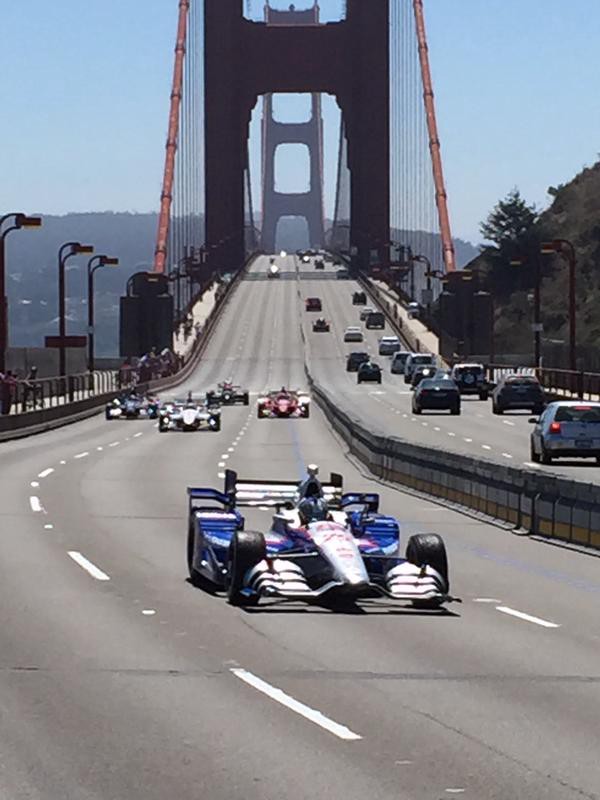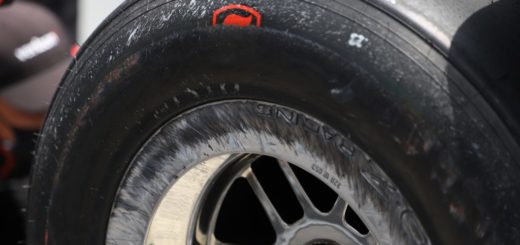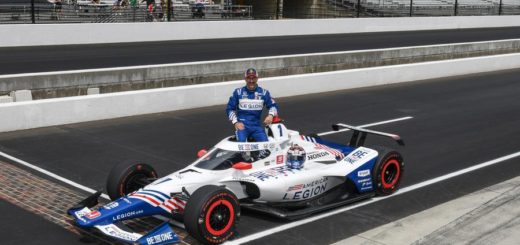One Day At Pocono
Triumph, tragedy and introspection in the Mountains
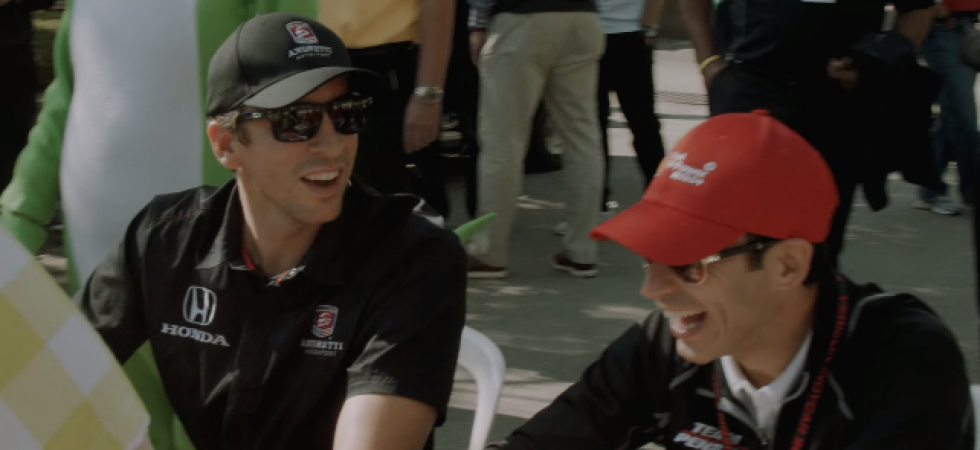
I think it’s always been hard for me to express to people who don’t follow IndyCar Racing why I love it so much — especially when people lose their lives in pursuit of speed.
Perhaps it was early exposure to racing when it was most exciting — 1985’s famous “Spin and Win” for Danny Sullivan in the Indy 500 is one of my earliest memories, back when ABC used to broadcast the race on tape delay. The speed, the technology, the competition and the innovation that went into making a car go 200mph, combined with the brashness of 1980s IndyCar drivers who thought themselves invincible because they could do the impossible. It all certainly left a lasting impact.
Because I lived in New York City for my youth, most of my ability to watch racing was limited to whatever was on broadcast television, and a few trips to the short-lived Meadowlands Grand Prix, the closest major motor racing ever really got to the Big Apple.
But, surely the danger was compelling too. IndyCars of the 1970s and 1980s were still in the beginning stages of a march towards safety that continues to this day, and surviving a “big one” was a matter of luck as much as safety. These men became modern day superheroes because of their death-defying feats.
Crashes happen, sure, but as technology improves, the likelihood of someone dying in at the track continues — usually these days it’s the result of freak accidents. In fact, the Pocono race weekend was not without its drama, as Charlie Kimball suffered a frightening-looking crash with the turn 3 wall during a qualifying run, and other high-speed accidents during the race (more about that later), left drivers a bit battered, and with bruised egos, but with no serious injuries
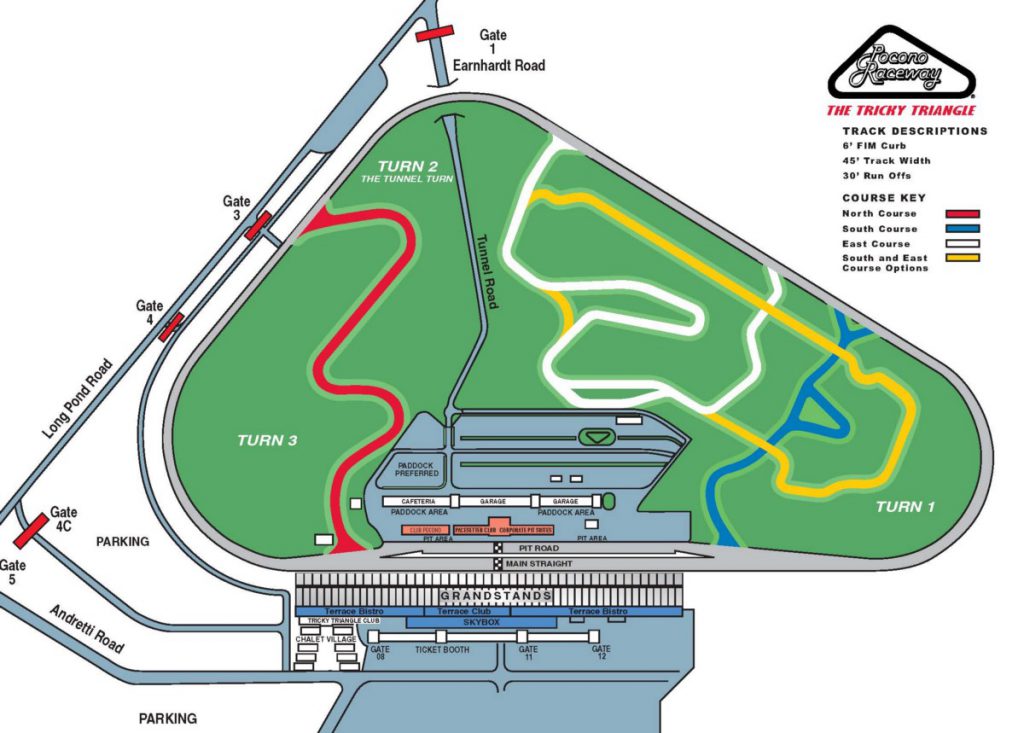
No one was thinking about such things as the day began on Sunday, August 23rd, 2015, as the IndyCar returned for their third trip around the “Tricky Triangle” at Pocono Raceway after a 25 year hiatus, and the mood was high. It would mark my first visit to the track, about 3 hours from New York City, and my first non-Indy 500 race since 1989.
The weather was beautiful, especially for the end of summer. Muggy air was replaced with dry, and sunlight ricocheted off seas of large and fluffy clouds which made the entire landscape stunning to look at. The sky was overcast. Perfect for a big day out at the track. It was by all accounts, a “very nice day.”
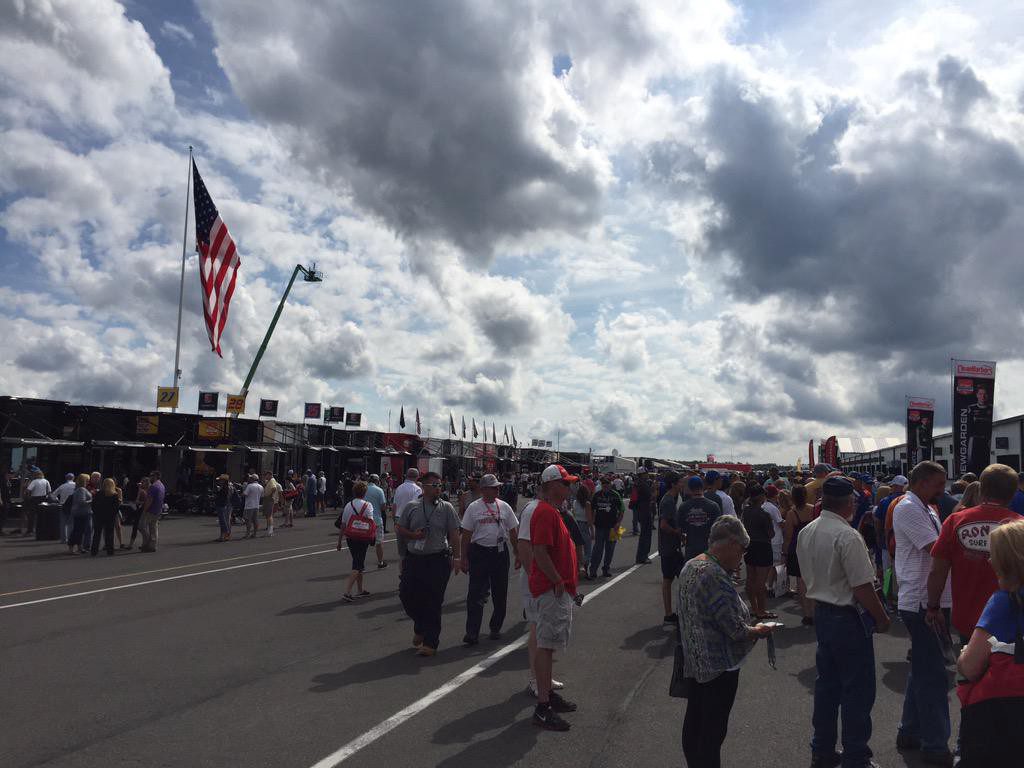
I had the pleasure of starting my day at Pocono with a garage visit with driver Pippa Mann. I was joined by my wife, who was attending her first ever IndyCar race. Pippa is typical of the underdog driver. She works hard to get every opportunity to race, and this morning found her in the Dale Coyne Racing garage — one of the teams that fights hard with a smaller budget and a lot of heart. Compared to some of the teams next door, the Dale Coyne garage is more spartan, but no less passionate. “Some of the hardest working people in the garage here,” I remark, and Pippa welcomes me in with an emphatic, “absolutely!”.
For Pippa, just making the single race at the Indy 500 is an annual challenge for her (more about her 2015 crowdfunding efforts with Susan G. Komen here), and getting additional race starts is never a guarantee. She does it for the love of the sport. She is making her 6th start of the 16th race IndyCar season, and her last of 2015.
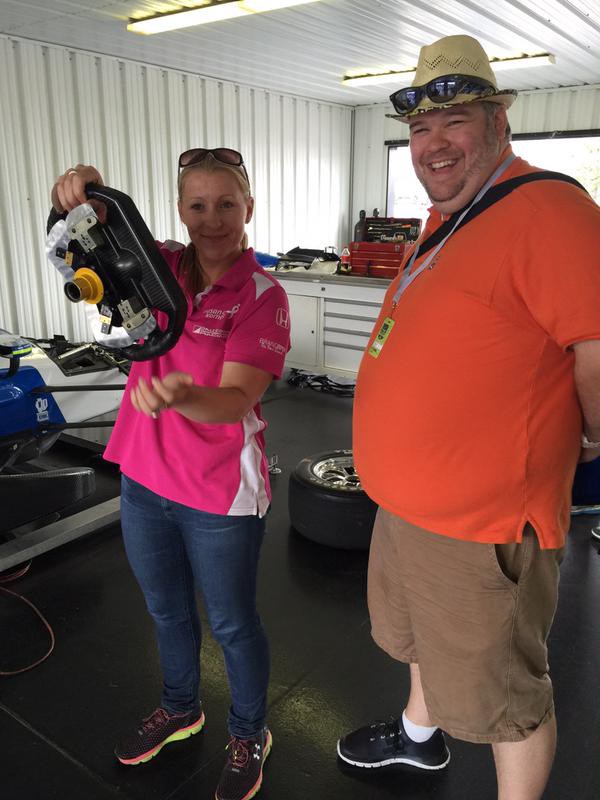
We spent about 20 minutes talking through race strategy (“We like the handling of the car a lot, so we’re not going to change it”), the challenges of getting into and out of the racecar, her joy about her better than expected qualifying, and what it’s like to have to be a part-time driver today — the challenges of working with countless team members, strategists, engineers, and new tracks is daunting. It’s even challenging even seeing out of the racecar (“The spotters are so important, because you can’t even really see out of the mirror”), and even her steering wheel is complex (“I can’t really see my display all that well, I shift based on the colors on the LED out of the corner of my eye.”).
Bottom line, for anyone who thinks hopping into a racecar is easy without a lot of prep is easy— it’s not. But she’d never say that. She is genuinely grateful for the chance. Pippa is pleasant, affable, super approachable, very well-spoken and genuinely loves what she does. But she’s realistic, too. And she’s hard not to root for (and would make a great spokesperson for another major sponsor —proven by all the work she does with Susan G. Komen).

Pocono Raceway is a really great place to see a race. Unlike Indianapolis, where you have to pick where you sit, and play a “pros and cons” game about what you’ll be able to see, Pocono has only one long grandstand along the main straightaway. It provides great views of the entire track, and it’s possible to see what’s happening from most of the higher level seats. Combine that with the alpine air, and nature all around, and it’s really a very pleasant place to spend an afternoon.
We left the garage and after taking the tunnel from the garage area to seats (note: the exit incline on the grandstand side of the tunnel is no joke), we emerged into the midway near the grandstand.
After the usual pre-race festivities, the race finally began. It was at this point that I graduated into full “race dork” mode and put on the scanner radio which allowed me to hear in-car radio and race control. It’s really a fun way to get behind the scenes of what’s happening on the track.
With that, the green flag fell to start the 200-lap, 500-mile race.
Pippa’s car had electrical problems early on in the race, putting her 17 laps behind before the race had even gotten started. She would spend the day fighting back to the front and would ultimately finish 13th, tying her career best finish. (More about her day here).
Among the race highlights:
- Lap 94: Fan favorite Graham Rahal’s title hunt took a serious hit with a crash in turn 3 with Tristan Vautier, with barbs traded back and forth amongst the drivers.
- Lap 163: Over the radio, something i’ll probably never hear again from race control: “Yellow flag for an animal on the racetrack.” Sure enough, it was a fox, and no, we don’t know what he said.
Yep, that did just happen #IndyCar pic.twitter.com/tGV2DP4QrM
— Mattzel89 (@Mattzel89) August 23, 2015
- Lap 166: After the fox ran away (safely), something else I’ll probably never see again (7 wide? 8 wide? 10 wide?). Somehow they made it through turn 1 before, another fan favorite, Helio Castroneves hit the wall, bringing out another caution period.
All in all, the IndyCar drivers put on an amazing show and through the cautions and attrition, on lap 180 of the 200 lap race, Pennsylvania native Sage Karam found himself in the lead on his home track. It was turning into everything a classic race needed: drama, competition, some danger (which drivers escaped injury from), a possible upset winner, and, above all, constant action. My wife, who had only seen IndyCar on TV was enjoying herself, as was I, as were the thousands gathered on this delightful Sunday afternoon.
And, then it happened. On lap 180, Karam spun out of turn 1 while in the lead, and hit the wall hard and at a very awkward angle. The impact drove parts off the car — which is what they are designed to do — to help dissipate the energy of a crash and avoid transforming it to the driver. Some of the pages were notably large, somewhat unusual, but not usually concerning because drivers and spotters (team members working from perches high above the track, allowing them to see), work plans through the debris fields.
After we saw Karam spin from the grandstand, hitting the wall, an audible moan from the crowd emerged; disappointment that their hometown hero wouldn’t be a winner today. What we didn’t see was that there was a second car involved that crashed quite a few seconds after Karam’s initial impact. After the moan came complete silence from the crowd after neither driver emerged quickly from their cars. We couldn’t see who the second car involved was.
Often (I can’t say usually), race control on the radio will announce something like “driver of the <number> car is out of the car” or reading off the numbers of the cars involved in the crash. This is for purposes of track clearing, but for to update the race team crews involved. This time, nothing came over the radio. From anyone. For either car. Or either team.
It was only through replays on video boards and the process of elimination as the cars came around for the next lap that we realized it was Justin Wilson, who had been running well all race. The crowd remained stone silent as the cleanup continued. Watching tweets from media on Twitter though, it became clear that it was a very critical situation.
Body language from crew is that this is a serious situation. Helicopter firing up to transport Justin Wilson.
— Nick Yeoman (@NYeoman) August 23, 2015
We couldn’t really see the impact of the debris from crash well from the video boards where we were initially, since they were off to our extreme left or extreme right, and where Justin’s car ended up was in a bit of blind spot at the bottom of the track. No one knew what happened. It was only then, that my brother watching the race from home, sent me a Twitter Direct Message saying only:
“debris hit his head”
The crowd waited silently for any kind of word. The PA played the race broadcast led by Paul Page and the IndyCar Radio team, and they didn’t speculate either — out of respect, and years of experience in covering this kind of moment, and also because they hadn’t been given any information. The debris theory started to gain some credence after a replay from the NBCSN broadcast showed on the video board from a few angles. A few moments later Karam limped from his car, and into the ambulance with minor injuries.
A few moments after that, we saw the rescue helicopter — which we knew the position of only because we’d parked directly behind it on the infield when we pulled in — start to fire up. An ambulance pulled up, and for a few minutes, there seemed to be a delay before the helicopter departed. Then it did.
Helicopters flying drivers out is never a good sign. The crowd understood what it meant immediately. Ninety-eight out of one hundred times a driver is treated and released from the well-equipped hospital at the track. The ninety-ninth time they are transported via ground ambulance to a local hospital. This was different. And very bad.
https://twitter.com/MatthewKnell/status/635573109421162498
The caution remained out and IndyCar released a simple statement a few seconds later:
Justin Wilson is being airlifted to Lehigh Valley Health Network Cedar Crest Hospital. No additional information is available at this time.
— NTT INDYCAR SERIES (@IndyCar) August 23, 2015
Many in the crowd would have likely been plenty happy if the race had finished under caution at that point; the silence was deafening, and many did not have the heart to care much about the winner. When underdog Gabby Chaves’ engine expired with 3 laps to go, the race did ultimately end under caution with the field slowly lapping til the checkered flag.
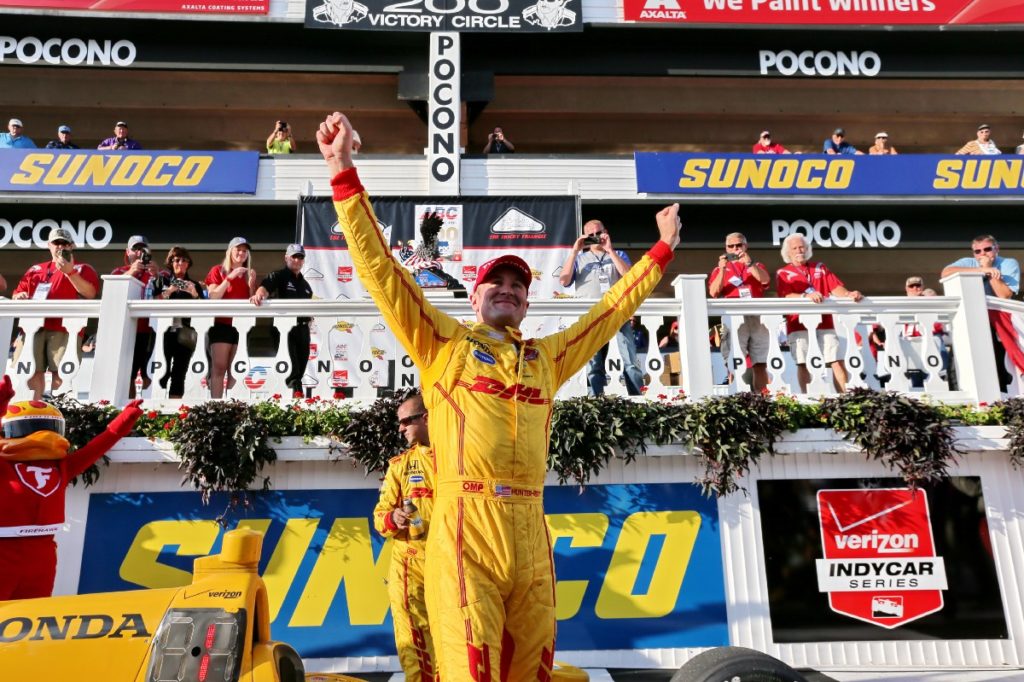
With the race decided with a few laps to go, people headed for the exits a bit more quickly than they may have otherwise. The track did the winner’s circle ceremony without the confetti. Car owner Michael Andretti, who owned both race winner Ryan Hunter-Reay’s race car and Justin’s, did what he could to keep composure. But, much like the crowd, the dichotomy of emotion between the joy of a great race, and the fear of the worst was overwhelming.
On the drive back to New York, we kept checking for updates on Justin’s condition, and beyond a few updates saying the same thing as the initial one, we didn’t find anything. Just a lot of drivers, fans and crews hoping for the best on Twitter and on TV. Justin was well-liked by everyone.
When I saw word that a press conference was scheduled for 9pm the next night, I instantly knew the news it would reveal. And, when it did, heartbreak reigned. My wife, who had never seen a race before, and only watched IndyCar on TV flashed back to the moment of Dan Wheldon’s crash, and how horrible it was. And she said, “I don’t really know how to feel about this. I was there when someone died. ” Her first experience with a live race, and a great time, and it ended in this unspeakable tragedy. And the dichtomy of joy vs pain again became clear.
#INDYCAR driver Justin Wilson has passed away from his injuries. #BadassWilson http://t.co/RzecwmzPgb pic.twitter.com/hMzwsnFswO
— NTT INDYCAR SERIES (@IndyCar) August 25, 2015
And as a long time race fan, I thought of other moments when tragedy struck. With Jeff Krosnoff. And Scott Brayton. And Greg Moore. And Gonzalo Rodriguez. And Dan Wheldon. And now Justin Wilson. You realize just how fragile life can be.
As a race fan, you have to balance the fact that this is part of something you love, and the guilt and pain it brings when things go wrong, weighed against the joy it brings you when things go right. It still hurts. But immeasurably less than the people who’s lived are directly impacted by the tragedy.
And, you echo the call for safety improvements. The HANS device. The SAFER barrier. Now, cockpit canopies. All in the hopes that no one ever has to feel that pain of loss ever again.
About a half hour after the news broke, IndyCar elder statesman, Indy 500 winner and IndyCar champion Tony Kanaan managed to put into words what everyone was thinking:
Why do we do this? Because we love it, don't want to be anywhere else but a race car. We will keep your legacy my friend. Racers race.
— Tony Kanaan (@TonyKanaan) August 25, 2015
And as a race fan, I too love it. I don’t put my life on the line every week. I don’t risk it all for a checked flag. But, I do feel the pain when someone is lost. And I do mourn for them and their families, and our sport. And, above all, thoughts and love go to their families. They should never be forgotten when the worst happens.
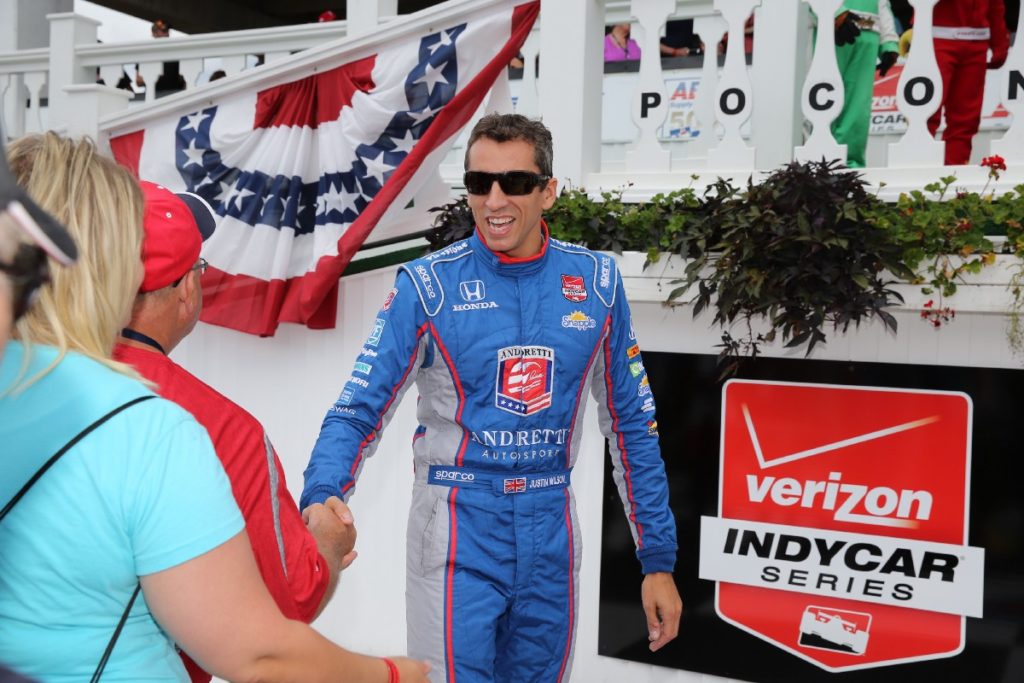
I think of Justin’s family now. And of all of the people that worked with him and loved him. And how they are hurting. And I think of how the sport will survive, because it always has.
And one day soon, the joy will return, too, for everyone who loves this sport.
And, if I have the chance to visit Pocono again, I will. Because it was a very memorable day — for all sorts of reasons.
